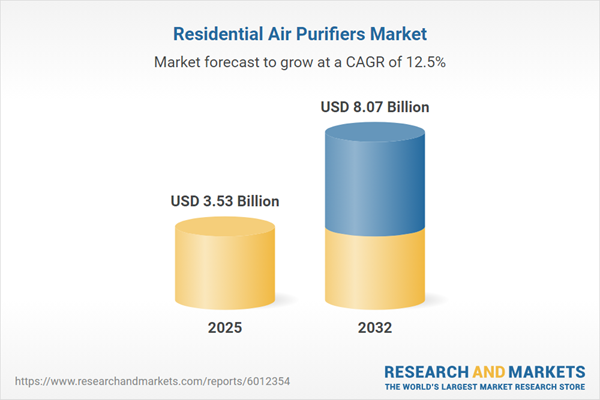Speak directly to the analyst to clarify any post sales queries you may have.
The residential air purifiers market is rapidly evolving in response to executive priorities for healthier indoor spaces and greater integration with smart home technology. Senior leaders recognize that targeted market intelligence is essential for aligning strategy with market drivers, driving continued investment and innovation.
Market Snapshot: Residential Air Purifiers Market Size and Growth
This sector has shown sustained global expansion, underpinned by heightened consumer concerns about indoor air quality. Market growth is influenced by health-focused purchasing behavior, the entrance of leading manufacturers and new competitors, and ongoing product enhancements. Advanced filtration and connected technology are now core priorities for product development, as companies seek to differentiate through wellness-oriented features and integration into home ecosystems. Regulations centering on occupant health, along with the steady introduction of new product functions, accelerate innovation and maintain the category’s relevance in residential management.
Scope & Segmentation of the Residential Air Purifiers Market
This report provides in-depth segmentation and regional analysis, delivering actionable insights to support informed investment and resource allocation. Coverage reflects major technological, regulatory, and end-user trends, providing senior decision-makers with a comprehensive view of where demand is shifting and how best to compete.
- Product Types: The portfolio includes desktop-portable units for small spaces, standalone devices for mid-sized areas, and integrated air purification systems for larger homes and multi-room environments.
- Technologies: Solutions feature activated carbon filters for managing airborne chemicals, HEPA filtration for particulate matter, negative ionization and ozone-based treatments for diverse pollutants, and UV purification for sterilization objectives.
- Distribution Channels: Companies utilize direct sales to consumers, relationships with established retailers, specialty stores, supermarkets, and digital platforms to access both volume-driven and premium segments.
- Applications: Product selection meets the need for allergy relief, respiratory health, pet dander reduction, and smoke or pollutant control across various residential settings.
- End User Segments: Residential air purifiers address apartments, single-family homes, multi-unit developments, and villas, with specific attention to ventilation requirements and demographic preferences.
- Regions Covered: The analysis spans the Americas, Europe, Middle East & Africa, and Asia-Pacific, detailing the United States, Canada, Germany, India, China, Japan, UAE, and Brazil, and capturing diverse regulatory and adoption dynamics.
Key Takeaways for Senior Decision-Makers
- Aligning design with functionality addresses the growing expectation that air purifiers blend seamlessly into connected, wellness-oriented residential environments.
- Sustainable procurement is increasingly important, leading organizations to favor products made with recycled and responsibly sourced components.
- Integrating with smart home infrastructure elevates air purifiers' value by enabling remote monitoring and supporting energy efficiency initiatives within homes.
- Collaborations between air quality specialists and technology partners drive continual improvement, incorporating machine learning and advanced diagnostics for adaptive performance.
- Flexible manufacturing and distribution, adapted to regional needs, reinforces supply chain resilience and ensures consistent market reach and operational stability.
- Targeted innovation enables manufacturers to address air quality requirements in both dense urban and high-end residential segments with tailored business models.
Tariff Impact: Navigating Supply Chains and Market Accessibility
Changes to tariff regulations in key markets, particularly the United States, necessitate greater agility in both sourcing and manufacturing strategies. Organizations are responding by diversifying supplier networks and emphasizing localized assembly, which helps safeguard operations against trade disruptions. Reliable distribution partners remain central for delivering product consistency and maintaining customer engagement throughout varied market segments.
Methodology & Data Sources
This report is built on primary interviews with industry leaders, expert validation, and competitive market tracking to ensure reliable, timely intelligence for executive decision-making. The triangulated analysis minimizes bias and enhances the utility of each finding.
Why This Report Matters for Strategic Planning
- Provides clear analysis of evolving consumer trends and regulatory frameworks, guiding investment to segments with the highest potential and supporting agile supply chain adaptation.
- Delivers up-to-date insight on key technology movements and emerging market dynamics, supporting leaders in capturing regional growth opportunities with confidence.
- Empowers organizations to anticipate risks and leverage regional data for targeted opportunity management and product adaptation.
Conclusion
By understanding the interplay of health, regulation, and technology in residential air purification, decision-makers are equipped to drive innovation and maintain a competitive, adaptive presence in the sector.
Additional Product Information:
- Purchase of this report includes 1 year online access with quarterly updates.
- This report can be updated on request. Please contact our Customer Experience team using the Ask a Question widget on our website.
Table of Contents
3. Executive Summary
4. Market Overview
7. Cumulative Impact of Artificial Intelligence 2025
Companies Mentioned
The companies profiled in this Residential Air Purifiers market report include:- Koninklijke Philips N.V.
- Honeywell International Inc.
- Daikin Industries, Ltd.
- Sharp Corporation
- LG Electronics Inc.
- 3M Company
- Panasonic Corporation
- Xiaomi Corporation
- Coway Co., Ltd.
- Dyson Ltd.
Table Information
| Report Attribute | Details |
|---|---|
| No. of Pages | 194 |
| Published | October 2025 |
| Forecast Period | 2025 - 2032 |
| Estimated Market Value ( USD | $ 3.53 Billion |
| Forecasted Market Value ( USD | $ 8.07 Billion |
| Compound Annual Growth Rate | 12.4% |
| Regions Covered | Global |
| No. of Companies Mentioned | 11 |









